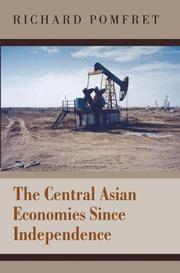| Listing 1 - 7 of 7 |
Sort by
|

ISBN: 1134320434 128005381X 0415332508 0203401425 020368463X 0415665876 1138010243 1134320426 Year: 2004 Publisher: London ; New York : Routledge,
Abstract | Keywords | Export | Availability | Bookmark
 Loading...
Loading...Choose an application
- Reference Manager
- EndNote
- RefWorks (Direct export to RefWorks)
In this volume the contributors use Geographical Information Systems (GIS) to reassess both historic and contemporary Asian countries and traditionally Islamic areas. This highly illustrated and comprehensive work highlights how GIS can be applied to the social sciences. With its description of how to process, construct and manage geographical data the book is ideal for the non-specialist looking for a new and refreshing way to approach Islamic area studies.
Geographic information systems --- Asia --- Islamic countries --- Geography. --- Geographical information systems --- GIS (Information systems) --- Muslim countries --- Asian and Pacific Council countries --- Information storage and retrieval systems --- Geography --- Eastern Hemisphere --- Eurasia --- space --- syntax --- spatial --- data --- objects --- axial --- lines --- map --- ferghana --- valley
Book
Abstract | Keywords | Export | Availability | Bookmark
 Loading...
Loading...Choose an application
- Reference Manager
- EndNote
- RefWorks (Direct export to RefWorks)
Material culture --- -Culture --- Folklore --- Technology --- Farghona Viloiati (Uzbekistan) --- -Antiquities --- -Farghona Viloiati (Uzbekistan) --- Culture --- Farghona Viloi︠a︡ti (Uzbekistan) --- Farghona wiloyati (Uzbekistan) --- Farghona Province (Uzbekistan) --- Farghăna (Uzbekistan : Wiloyat) --- Fergana Region (Uzbekistan) --- Fargʹona Province (Uzbekistan) --- Fergana Province (Uzbekistan) --- Ferghana Province (Uzbekistan) --- Ferganskai︠a︡ oblastʹ (Uzbekistan) --- Antiquities.
Book
ISBN: 0801449979 0801470897 9780801470899 9780801477065 0801477069 0801470889 9780801449970 1322522871 9780801470882 Year: 2014 Publisher: Ithaca, New York ; London : Cornell University Press,
Abstract | Keywords | Export | Availability | Bookmark
 Loading...
Loading...Choose an application
- Reference Manager
- EndNote
- RefWorks (Direct export to RefWorks)
In Central Asia's Ferghana Valley, where Kyrgyzstan, Uzbekistan, and Tajikistan meet, state territoriality has taken on new significance in these states' second decade of independence, reshaping landscapes and transforming livelihoods in a densely populated, irrigation-dependent region. Through an innovative ethnography of social and spatial practice at the limits of the state, Border Work explores the contested work of producing and policing "territorial integrity" when significant stretches of new international borders remain to be conclusively demarcated or effectively policed.Drawing on extensive ethnographic fieldwork, Madeleine Reeves follows traders, farmers, water engineers, conflict analysts, and border guards as they negotiate the practical responsibilities and social consequences of producing, policing, and deriving a livelihood across new international borders that are often encountered locally as "chessboards" rather than lines. She shows how the negotiation of state spatiality is bound up with concerns about legitimate rule and legitimate movement, and explores how new attempts to secure the border, materially and militarily, serve to generate new sources of lived insecurity in a context of enduring social and economic inter-dependence. A significant contribution to Central Asian studies, border studies, and the contemporary anthropology of the state, Border Work moves beyond traditional ethnographies of the borderland community to foreground the effortful and intensely political work of producing state space.
Borderlands --- Ethnology --- Fergana Valley --- Politics and government. --- Ethnic relations. --- Cultural anthropology --- Ethnography --- Races of man --- Social anthropology --- Border-lands --- Border regions --- Frontiers --- Farghona Valley --- Farghona Wodisi --- Fargʺona vodiĭsi --- Fergana Basin --- Fergana öröönü --- Fergana Oydungu --- Ferganskai︠a︡ dolina --- Ferganskaya dolina --- Ferghana Valley --- Vodii Farghona --- Anthropology --- Human beings --- Boundaries
Book
ISBN: 1315704374 1317470664 1283147793 9786613147790 076563001X 9780765630018 9780765630001 0765630001 9780765629982 0765629984 9781315704371 9781317470649 9781317470656 9780765629999 0765629992 Year: 2011 Publisher: Armonk, N.Y. : M.E. Sharpe,
Abstract | Keywords | Export | Availability | Bookmark
 Loading...
Loading...Choose an application
- Reference Manager
- EndNote
- RefWorks (Direct export to RefWorks)
This volume offers a comprehensive examination of the process of performance management. It provides a balance between concepts and skills-based exercises. Conceptual understanding is addressed, followed by a variety of "skill-builder" excercises, which provide a rich resource for students.
Fergana Valley --- Farghona Valley --- Farghona Wodisi --- Fargʺona vodiĭsi --- Fergana Basin --- Fergana öröönü --- Fergana Oydungu --- Ferganskai︠a︡ dolina --- Ferganskaya dolina --- Ferghana Valley --- Vodii Farghona --- Geography. --- History. --- Social conditions. --- History --- Geography --- Social conditions --- Fergana Valley - History --- Fergana Valley - Geography --- Fergana Valley - Social conditions
Book
ISBN: 0253021499 9780253021496 9780253021274 9780253021380 0253021383 0253021278 9780253021274 Year: 2016 Publisher: Bloomington, Indiana
Abstract | Keywords | Export | Availability | Bookmark
 Loading...
Loading...Choose an application
- Reference Manager
- EndNote
- RefWorks (Direct export to RefWorks)
Muslim Women of the Fergana Valley is the first English translation of an important 19th-century Russian text describing everyday life in Uzbek communities. Vladimir and Maria Nalivkin were Russians who settled in a "Sart" village in 1878, in a territory newly conquered by the Russian Empire. During their six years in Nanay, Maria Nalivkina learned the local language, befriended her neighbors, and wrote observations about their lives from birth to death. Together, Maria and Vladimir published this account, which met with great acclaim from Russia's Imperial Geographic Society and among Orientalists internationally. While they recognized that Islam shaped social attitudes, the Nalivkins never relied on common stereotypes about the "plight" of Muslim women. The Fergana Valley women of their ethnographic portrait emerge as lively, hard-working, clever, and able to navigate the cultural challenges of early Russian colonialism. Rich with social and cultural detail of a sort not available in other kinds of historical sources, this work offers rare insight into life in rural Central Asia and serves as an instructive example of the genre of ethnographic writing that was emerging at the time. Annotations by the translators and an editor's introduction by Marianne Kamp help contemporary readers understand the Nalivkins' work in context.
Ethnology --- Sarts (Asian people) --- Muslim women --- Islamic women --- Women, Muslim --- Women --- Cultural anthropology --- Ethnography --- Races of man --- Social anthropology --- Anthropology --- Human beings --- Social life and customs --- Fergana Valley --- Farghona Valley --- Farghona Wodisi --- Fargʺona vodiĭsi --- Fergana Basin --- Fergana öröönü --- Fergana Oydungu --- Ferganskai︠a︡ dolina --- Ferganskaya dolina --- Ferghana Valley --- Vodii Farghona --- Description and travel. --- Social conditions.
Book
ISBN: 0691054940 0691216304 Year: 1987 Publisher: Princeton (N.J.): Princeton university press
Abstract | Keywords | Export | Availability | Bookmark
 Loading...
Loading...Choose an application
- Reference Manager
- EndNote
- RefWorks (Direct export to RefWorks)
This narrative history of the Tibetan Empire in Central Asia from about A.D. 600 to 866 depicts the struggles of the great Tibetan, Turkic, Arab, and Chinese powers for dominance over the Silk Road lands that connected Europe and East Asia. It shows the importance of overland contacts between East and West in the Early Middle Ages and elucidates Tibet's role in the conflict over Central Asia.
Asia, Central --- Tibet Autonomous Region (China) --- History. --- China --- Central Asia --- Aachen. --- An Lu-shan. --- Atlakh. --- Bayarqu. --- Bilgä Qaghan. --- Buddhism. --- Camel Bridge. --- Charlemagne. --- Ch’ang-an. --- Damascus. --- Ferghana. --- Gobi Desert. --- Hami. --- Harun al-Rashid. --- Ho-hsi. --- Hsüan-tsung. --- Islam. --- Issyk Kul. --- Japanese. --- Jungarian Basin. --- Kan chou. --- Kao Hsien-chih. --- Kashgar. --- Kashmir. --- Khuganda. --- Liang chou. --- Little Balûr. --- Mediterranean Sea. --- Nan-chao. --- Ordos. --- Oxus River. --- Pamirs. --- Qośu Khan. --- Samarkand. --- agriculture. --- castles. --- commerce and merchants. --- conversion and apostasy. --- embassies and envoys. --- ethnicity. --- fish-bags. --- gold. --- horses.

ISBN: 0691124655 Year: 2006 Publisher: Princeton Princeton university press
Abstract | Keywords | Export | Availability | Bookmark
 Loading...
Loading...Choose an application
- Reference Manager
- EndNote
- RefWorks (Direct export to RefWorks)
The 9/11 attacks, the U.S. invasion of Afghanistan, and the oil boom of recent years have greatly increased the strategic importance of resource-rich Central Asia, making an understanding of its economic--and therefore political--prospects more important than ever. In The Central Asian Economies Since Independence, Richard Pomfret provides a concise and up-to-date analysis of the huge changes undergone by the economies of Kazakhstan, the Kyrgyz Republic, Tajikistan, Turkmenistan, and Uzbekistan since the collapse of the Soviet Union in 1991. The book assesses the economic prospects of each country, and the likelihood that economic conditions will spur major political changes. With independent chapters on each country, and chapters analyzing their comparative economic performance, the book highlights similarities and differences. Facing common problems caused by the breakdown of Soviet economic relations and the hyperinflation of the early 1990s, these countries have taken widely divergent paths in the transition from Soviet central planning to more market-based economies. The book ends in 2005 with the bloodless Kyrgyz revolution and the violence in Uzbekistan, which signaled the end of the region's political continuity. Throughout the book, Pomfret emphasizes the economic forces that foster political instability--from Kazakhstan's resource boom and Turkmenistan's lack of reform to Tajikistan's abject poverty.
330.958 --- 331.30 --- 37 --- CIS / Commonwealth Of Independant States - Gos - Cei --- KG / Kyrgyzstan - Kirghizistan --- KZ / Kazakhstan --- TJ / Tajikistan - Tadzjikistan - Tadjikistan --- TM / Turkmenistan --- UZ / Uzbekistan - Oezbekistan - Ouzbekistan --- 338 <5-011> --- 338 <5-011> Economische situatie. Economische structuur van bepaalde landen en gebieden. Economische geografie. Economische produktie.economische produkten. Economische diensten--Nabije-Oosten. Midden-Oosten --- Economische situatie. Economische structuur van bepaalde landen en gebieden. Economische geografie. Economische produktie.economische produkten. Economische diensten--Nabije-Oosten. Midden-Oosten --- Economische toestand --- Geografische economie. Monografieën van streken en landen --- Asia, Central --- Economic conditions --- Economic policy --- Politics and government --- Economic policy. --- Economic history. --- Central Asia. --- Afghanistan. --- Agip. --- Almaty. --- Aral Sea. --- Azerbaijan. --- Bishkek. --- Caspian Sea. --- Chevron. --- Daewoo. --- Dutch disease. --- Fergana oblast. --- Ferghana Valley. --- Gini coefficent. --- Islamic Renaissance Party (IRP). --- Japan. --- Karachaganak. --- Karakalpakstan. --- Kumtor gold mine. --- Mongolia. --- Nazarbayev, Nursultan. --- North Korea. --- Osh. --- Pakistan. --- South Korea. --- Tajikistan. --- Tashkent. --- Tengiz. --- Turkey. --- Turkmenbashi. --- Ukraine. --- Uzbekistan. --- World Bank. --- aluminium. --- corruption. --- enclaves. --- ethnic tensions. --- external debt. --- financial sector. --- forced labor. --- household surveys. --- hydroelectricity. --- income distribution. --- inflation. --- irrigation. --- migration. --- natural gas. --- opium. --- pensions. --- poverty. --- privatization. --- remittances. --- ruble zone. --- shuttle trade. --- transit. --- unemployment. --- History, Economic --- Economics --- Economic nationalism --- Economic planning --- National planning --- State planning --- Planning --- National security --- Social policy --- Central Asia --- Soviet Central Asia --- Tūrān --- Turkestan --- West Turkestan --- Asia --- Political aspects
| Listing 1 - 7 of 7 |
Sort by
|

 Search
Search Feedback
Feedback About UniCat
About UniCat  Help
Help News
News